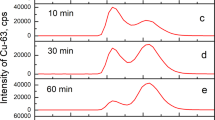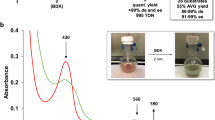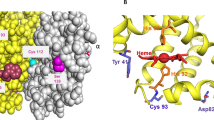Abstract
IT was thought that, analogously to the iron in hæmoglobin, the copper of hæmocyanin remained in the cuprous (Cu+) state when the pigment took up oxygen1. This was questioned2 because the characteristic blue colour of the cupric ion (Cu++) appeared when oxyhæmocyanin was formed, as well as on other grounds. It has since been shown3, using the hæmocyanin of Busycon, Loligo, Homarus and Limulus, that in fact half the copper becomes Cu++ and the rest remains Cu+. There was occasion to confirm this on the bloods of Helix and Maia, in the course of other work4. Klotz and Klotz3 showed that the oxygenation probably depends on the co-operation of the two ions. A number of further differences in properties between hæmocyanin and hæmoglobin also were explained by their important discovery.
This is a preview of subscription content, access via your institution
Access options
Similar content being viewed by others
References
Dawson, C. R., and Malette, M. F., “Adv. Protein Chem.”, 2, 179 (1945).
Schulman, M. P., and Wald, G., Biol. Bull. Woods Hole, 101, 239 (1951).
Klotz, I. M., and Klotz, T. A., Science, 121, 477 (1955).
Needham, A. E., Comp. Biochem. Physiol., 1, 72 (1960).
Conant, J. B., et al., J. Biol. Chem., 101, 463 (1933).
Author information
Authors and Affiliations
Rights and permissions
About this article
Cite this article
NEEDHAM, A. The Problem of ‘Methæmocyanin’. Nature 189, 308–309 (1961). https://doi.org/10.1038/189308a0
Issue Date:
DOI: https://doi.org/10.1038/189308a0
This article is cited by
-
Nitrite toxicity to the crayfishProcambarus clarkii
Bulletin of Environmental Contamination and Toxicology (1985)
-
Radiation Protection by Cyanide of both Rats and Mice
Nature (1963)
Comments
By submitting a comment you agree to abide by our Terms and Community Guidelines. If you find something abusive or that does not comply with our terms or guidelines please flag it as inappropriate.



